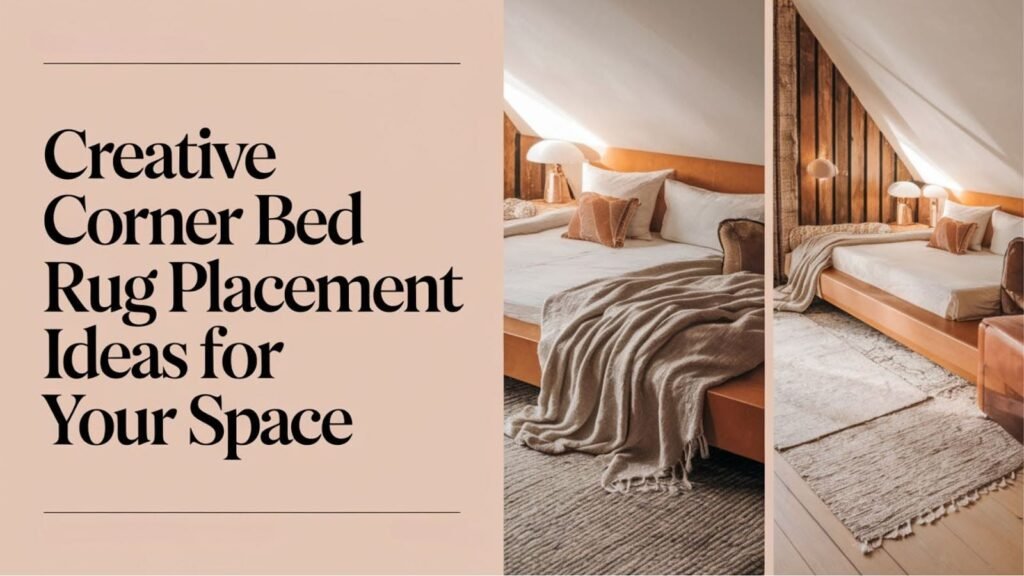A corner bed setup positions your bed against two intersecting walls, creating a cozy nook that maximizes floor space while offering a special design opportunity.
This arrangement presents specific challenges for rug placement, as traditional centering techniques don’t always work with angular positioning.
Proper rug placement in corner bed layouts significantly impacts your room’s visual flow, comfort level, and overall functionality.
A thoughtfully positioned rug can ground the space, define sleeping areas, and create seamless transitions between different room zones.
This comprehensive guide presents 13 innovative rug placement strategies specifically designed for corner bed configurations.
You’ll learn how to balance asymmetrical layouts, maximize small spaces, and create cohesive design schemes that make your corner bed feel intentional and stylish rather than cramped or awkward.
List of 13 Rug Placement Ideas
Smart rug positioning converts corner bed setups from awkward arrangements into stylish, functional spaces that maximize comfort and visual appeal.
1. Diagonal Rug Under the Bed
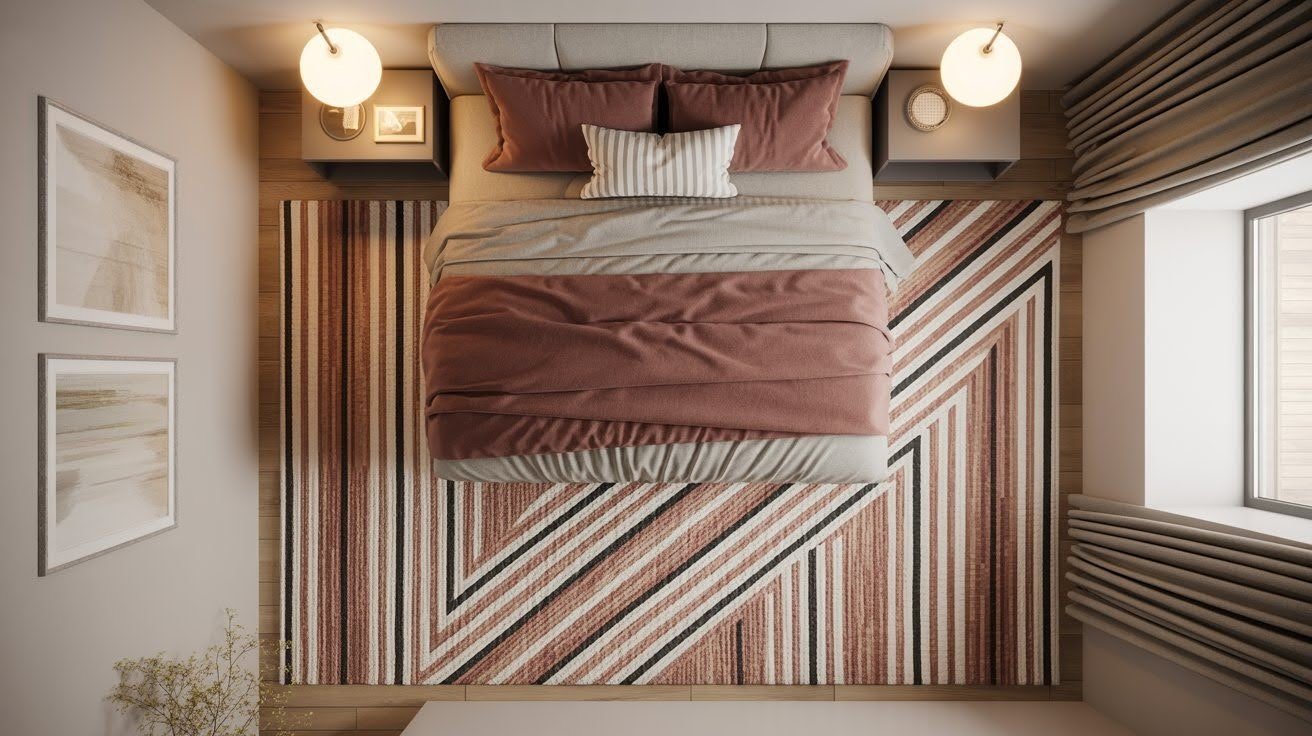
Position your rug at a 45-degree angle beneath the bed frame to create visual interest and complement angled furniture arrangements.
This placement technique adds dynamic movement to the room while breaking away from traditional parallel positioning.
The diagonal approach works particularly well in square rooms where you want to soften rigid geometric lines and create a more fluid, organic feel.
2. Large Area Rug Anchoring the Entire Corner
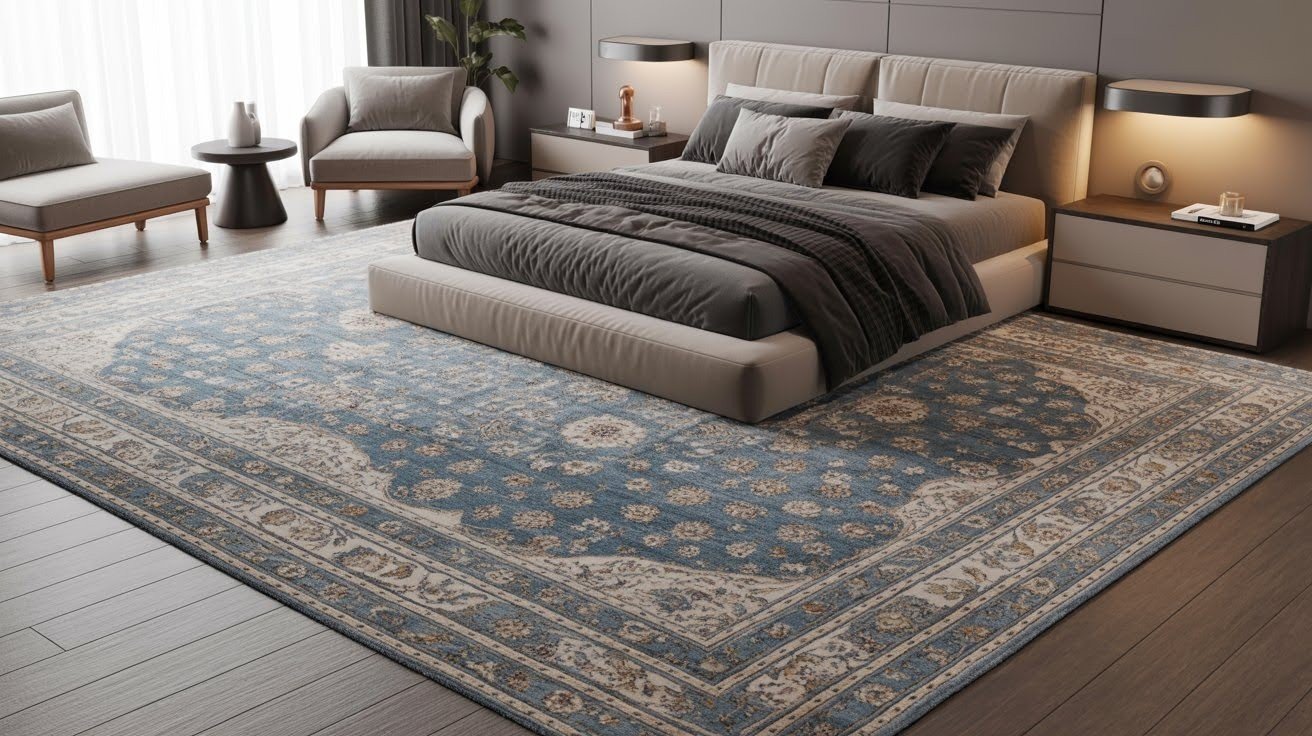
Choose an oversized rug that extends well beyond the bed’s perimeter, covering both the sleeping area and surrounding floor space.
This approach works best in spacious bedrooms where you have ample room to accommodate a substantial rug without overwhelming the space.
The large coverage creates a cohesive foundation that unifies the corner bed with other furniture pieces.
3. Layered Rugs for a Boho Vibe
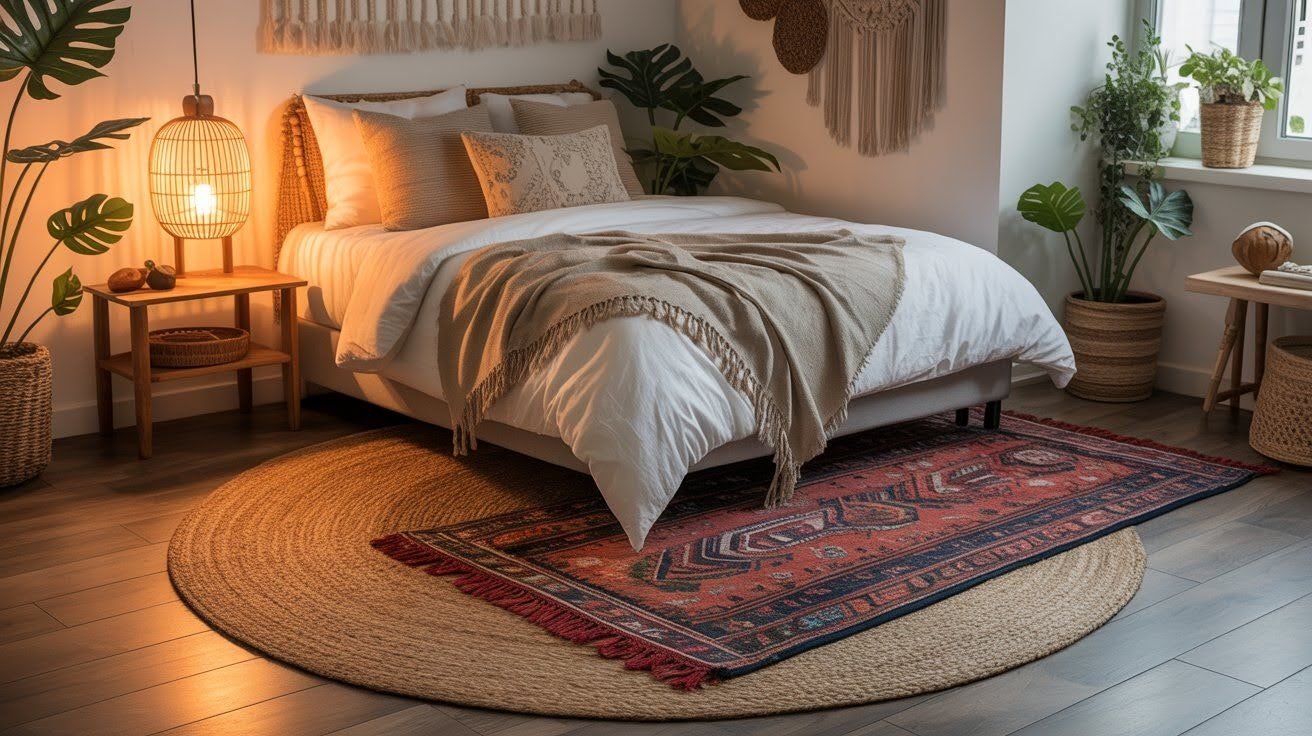
Start with a neutral base rug in jute or sisal, then add a smaller, colorful patterned rug on top.
This layering technique creates depth and visual interest while allowing you to incorporate multiple textures and patterns.
The combination works exceptionally well with eclectic or casual design themes, adding personality without committing to one bold statement piece.
4. Asymmetrical Rug Placement Along Open Sides

Position the rug only along the bed’s accessible sides, leaving the corner walls free of coverage.
This approach maintains an open, airy feeling while providing comfort where you actually step.
The asymmetrical placement prevents the space from feeling boxed in and allows natural light to reflect off bare flooring.
5. Fluffy Rug Tucked Just Under the Foot of the Bed
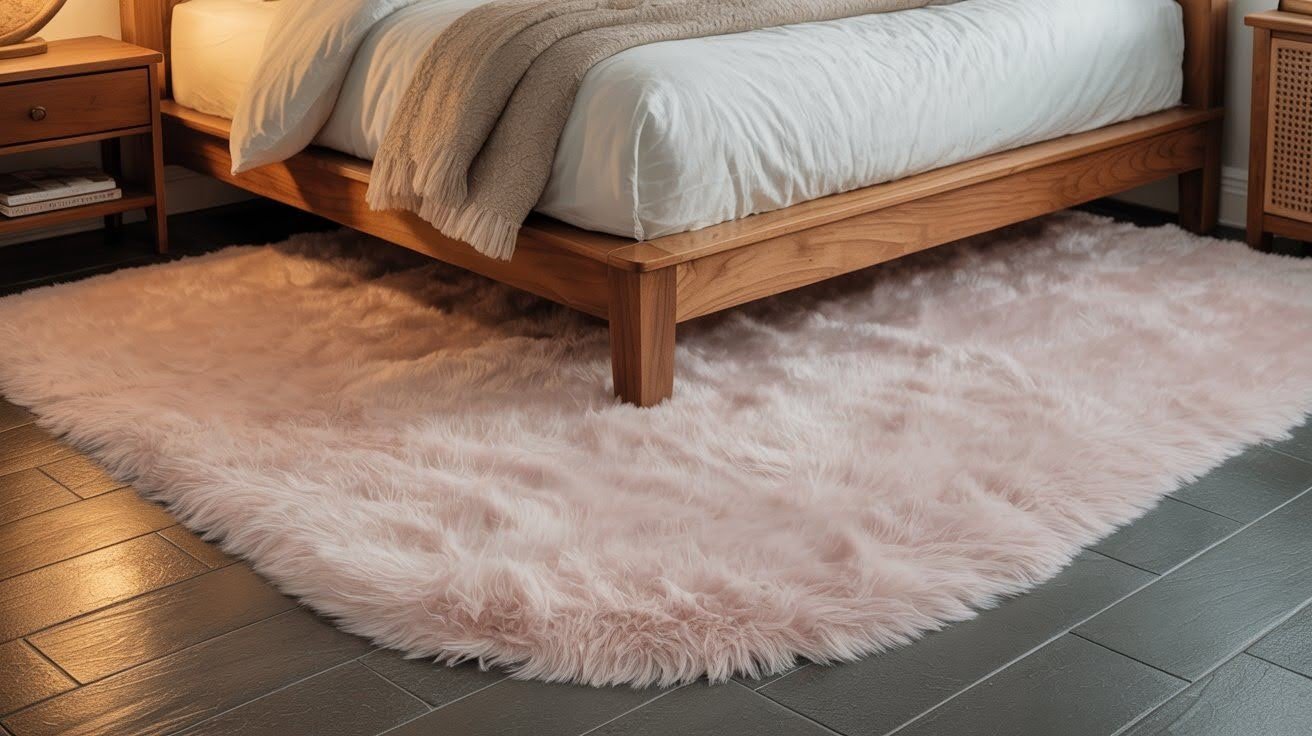
Place a plush, high-pile rug partially underneath the bed’s foot end, creating a cozy landing spot for your feet each morning.
This placement provides luxurious texture exactly where you need it most while drawing visual attention to the bed’s footboard area.
The soft material contrasts beautifully with harder bedroom surfaces.
6. Wall-to-Wall Rug for Unified Look
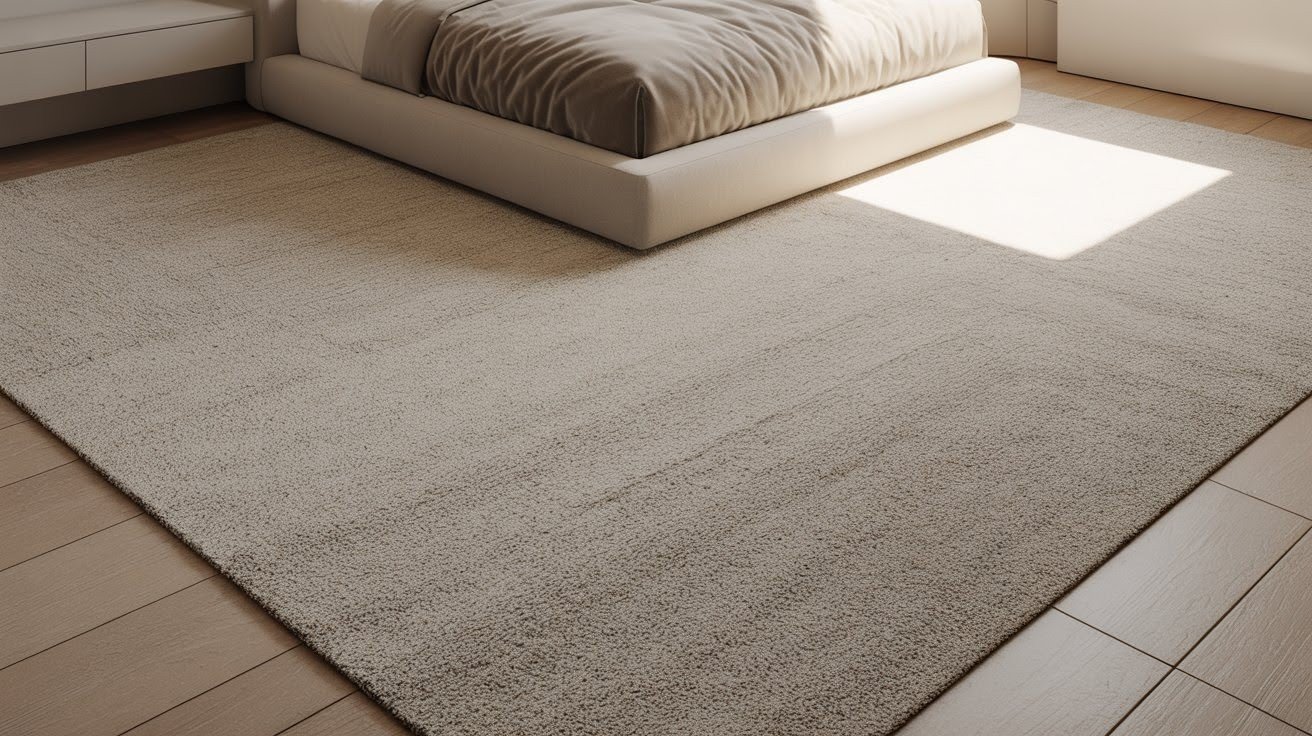
Install carpeting or a fitted rug that covers the entire floor space, creating seamless integration between the corner bed and surrounding area.
This approach works particularly well in studio apartments or minimalist spaces where you want the bed to appear as a natural extension of the room rather than a separate furniture piece.
7. Bold Patterned Rug Framed by the Bed
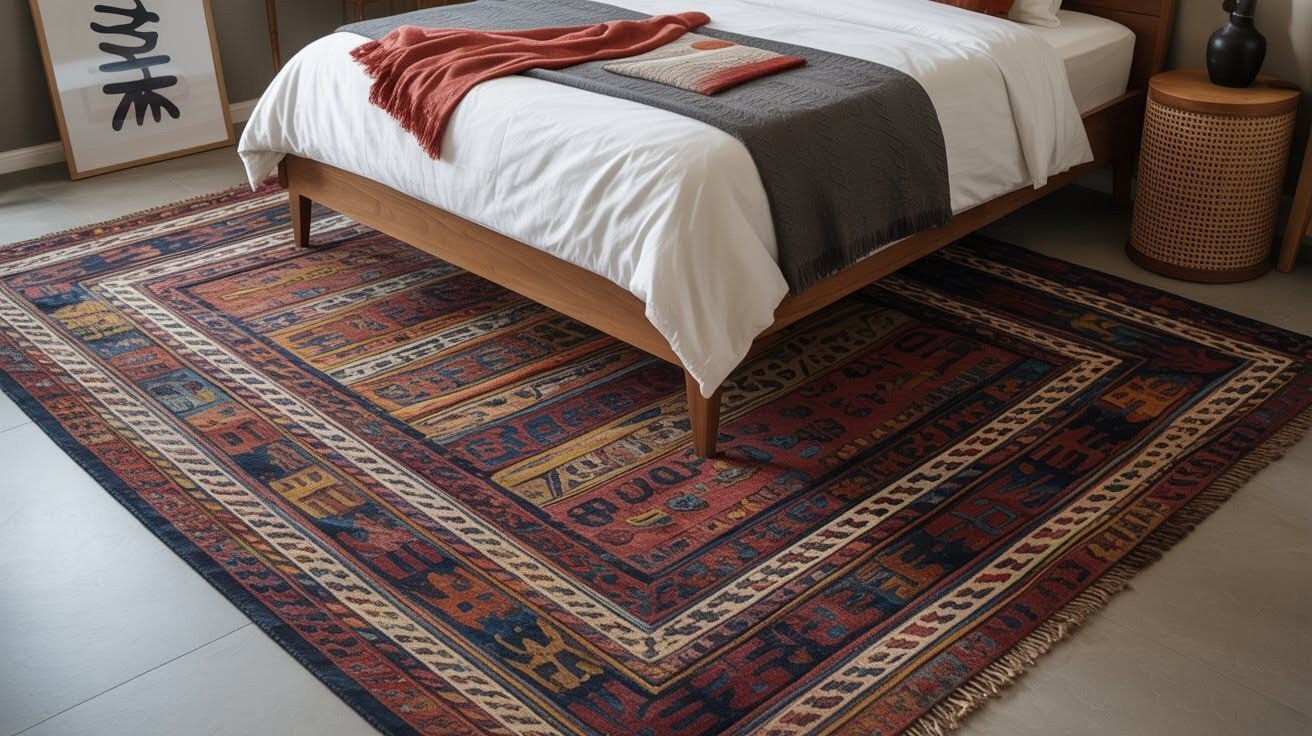
Select a rug with striking patterns or colors and position it so the bed’s frame creates natural boundaries around the design.
This technique turns your floor covering into an artistic statement piece while using the bed’s structure as a built-in frame.
The bold pattern becomes a focal point that adds personality to the corner arrangement.
8. Small Accent Rug at the Side Entry Point
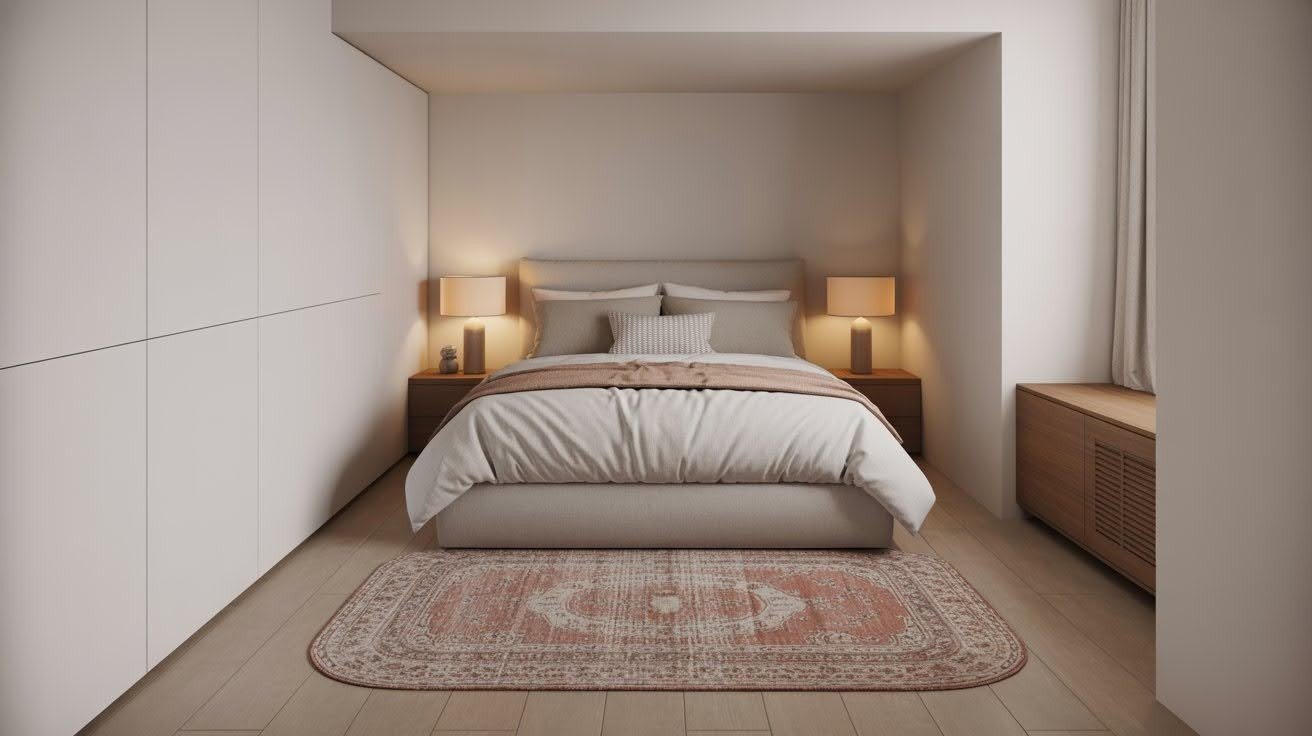
Place a compact rug at the primary access point to your corner bed, creating a designated landing area for your feet.
This solution works well in narrow rooms or spaces with limited floor area, providing comfort and style without overwhelming the layout.
The small size maintains visual openness while adding functional benefits.
9. Round Rug for a Soft Visual Contrast
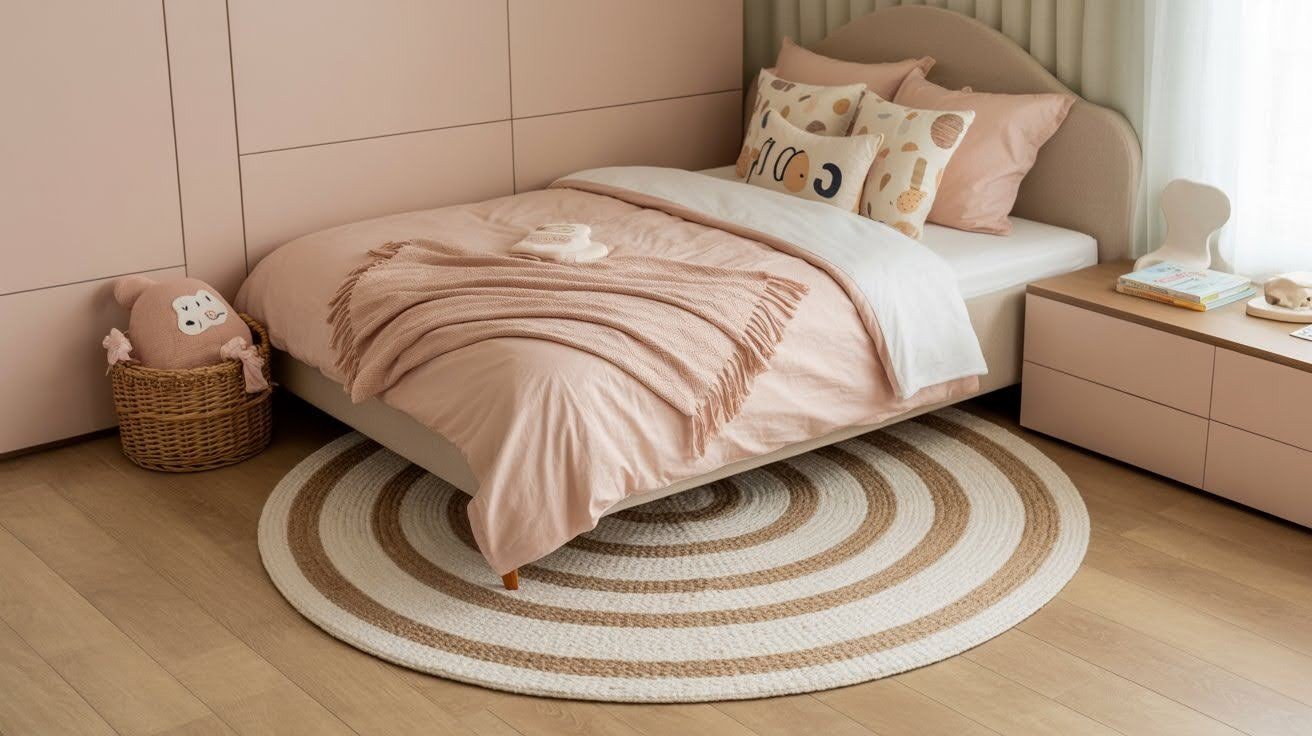
Choose a circular rug to balance the straight lines and angular positioning of your corner bed setup.
The curved shape provides visual relief from the geometric arrangement while creating a more playful, approachable atmosphere.
This option works particularly well in children’s rooms or spaces with softer design aesthetics.
10. Textured Natural Fiber Rug

Select a rug made from jute, sisal, or seagrass to add organic texture and earthy warmth to your corner bed area.
These natural materials complement wood furniture and neutral color schemes while providing subtle visual interest through their woven patterns.
The natural fibers create a calming, grounded atmosphere in the sleeping space.
11. Shag Rug Just Beneath the Headboard Corner
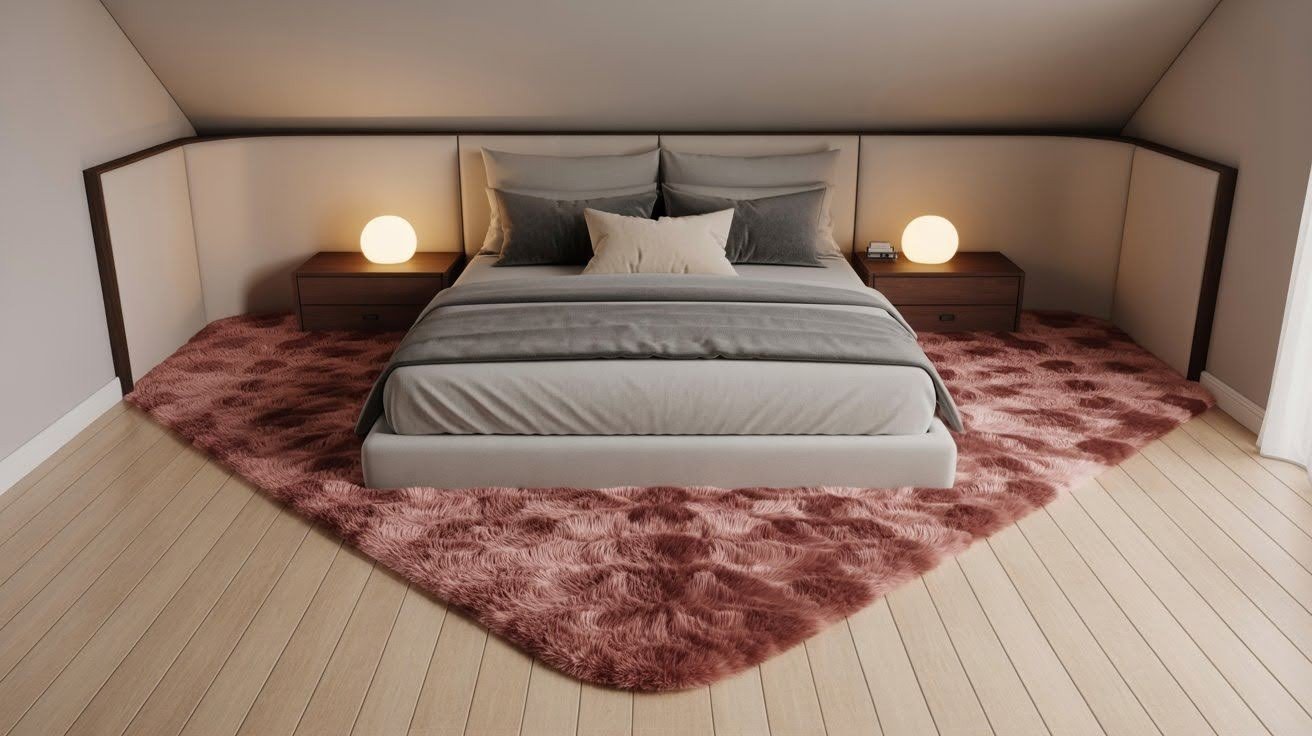
Position a high-pile shag rug in the corner where your headboard meets the walls, creating a soft, comfortable area for reading or relaxing in bed.
This placement focuses on luxury where you spend the most time while visually softening the sharp angles created by the bed’s corner positioning.
12. L-Shaped Custom Rug Fit to the Corner Layout
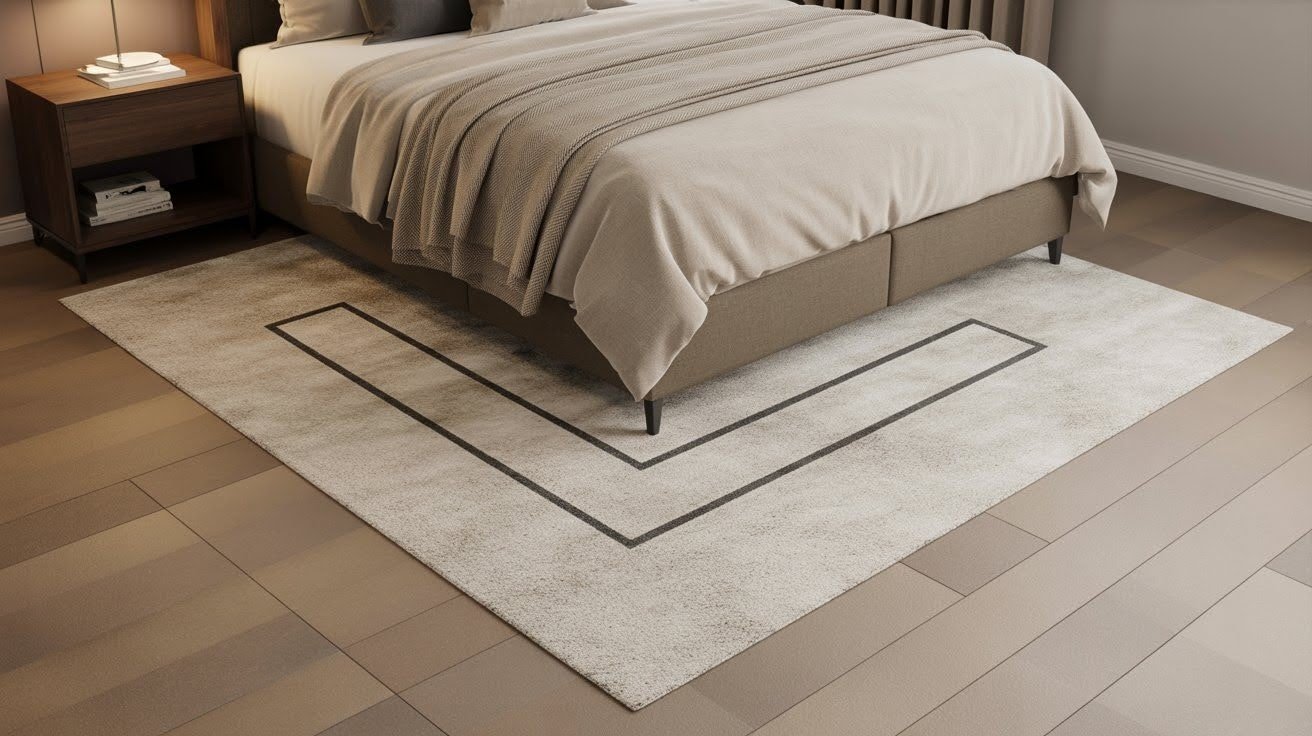
Commission or create a custom L-shaped rug that perfectly matches your corner bed’s footprint and room dimensions.
This solution maximizes floor coverage while accommodating unique room shapes or unusual furniture arrangements.
The custom fit ensures optimal use of available space without awkward gaps or overlaps.
13. Dual Rugs: One Under Bed, One Beside It
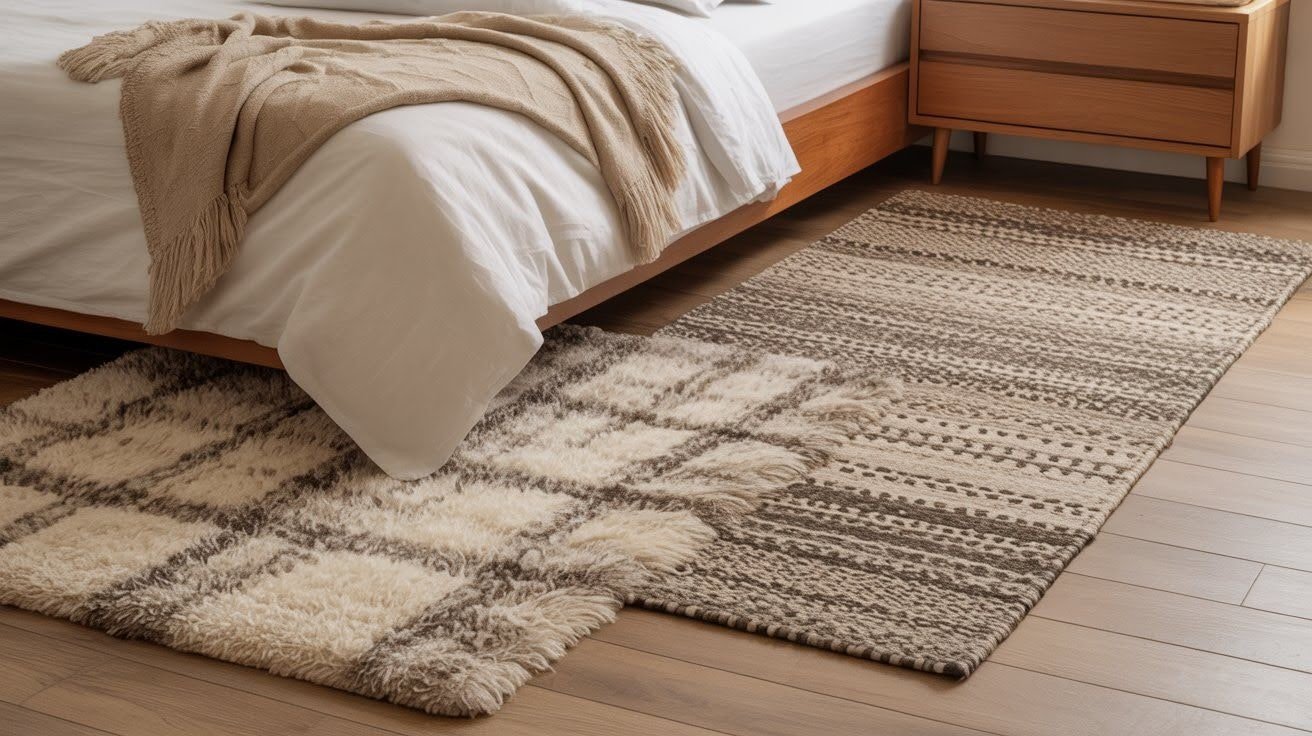
Use two complementary rugs to create distinct zones within your corner bed area.
Place one rug partially under the bed and position a second rug alongside it for additional floor coverage.
This approach allows you to mix textures, colors, or patterns while maintaining visual connection between the two pieces.
Tips for Choosing the Right Rug for a Corner Bed
Consider Room Size and Bed Dimensions
- Measure your available floor space carefully before selecting a rug size, ensuring adequate clearance around furniture while maintaining visual balance
- In smaller rooms, choose rugs that extend 18-24 inches beyond the bed’s perimeter, while larger spaces can accommodate more generous proportions
- The rug should complement your bed’s scale without overwhelming the room or appearing too small for the furniture arrangement
Match Rug Material to Room Function
- Select rug materials based on your bedroom’s primary activities and maintenance preferences
- High-traffic areas benefit from durable materials like wool or synthetic fibers that resist wear and clean easily
- For purely decorative spaces, delicate materials like silk or cotton work well, while family bedrooms require stain-resistant options that can handle daily use and occasional spills
Don’t Forget Color Harmony and Style
- Choose rug colors that complement your existing bedding, wall colors, and furniture finishes to create a cohesive design scheme
- Neutral rugs provide versatility and longevity, while bold colors can serve as accent pieces that tie together various room elements
- Consider your room’s natural lighting when selecting colors, as corner placements may receive different light exposure than central locations
Safety First – Use Non-Slip Pads in Corners
- Install quality rug pads beneath your corner bed rug to prevent sliding and create a safer walking surface
- Corner placements are particularly prone to shifting due to limited furniture weight holding them in place
- Non-slip pads also extend rug life by reducing wear from movement and provide additional cushioning for improved comfort underfoot
Conclusion
These 13 creative rug placement strategies demonstrate how thoughtful positioning can convert any corner bed setup from a space-saving necessity into a stunning design feature.
From diagonal arrangements that add movement to layered combinations that create depth, each approach offers unique benefits for different room sizes and style preferences.
Don’t hesitate to experiment with various layouts, materials, and layering techniques to find what works best for your specific space.
Mix textures, play with proportions, and test different positioning options until you achieve the perfect balance of comfort and visual appeal.
Remember, the right rug placement has the power to turn even the most basic corner bed arrangement into a focal point that showcases your personal style while maximizing both function and beauty in your bedroom sanctuary.
Frequently Asked Questions
What size rug works best for a corner bed setup?
Choose a rug that extends 18-24 inches beyond your bed’s perimeter for optimal visual balance. In smaller rooms, prioritize functionality over coverage, while larger spaces can accommodate more generous rug proportions.
Can I use multiple rugs with a corner bed arrangement?
Yes, layering rugs or using dual placements creates visual interest and functional zones. Try combining a neutral base with a patterned accent rug, or place separate rugs under and beside the bed.
How do I prevent my corner bed rug from sliding?
Always use high-quality non-slip pads beneath your rug to prevent movement and improve safety. Corner placements are especially prone to shifting since less furniture weight holds them in position.
Should I match my rug color to my bedding or walls?
Consider your room’s overall color scheme and choose rugs that complement existing elements without exact matching. Neutral rugs offer versatility, while bold colors can serve as accent pieces that tie the room together.
What rug materials work best for bedroom corner placements?
Select materials based on your room’s function and maintenance needs. Wool and synthetic fibers offer durability for high-traffic areas, while cotton and silk work well in decorative spaces with lighter use.

